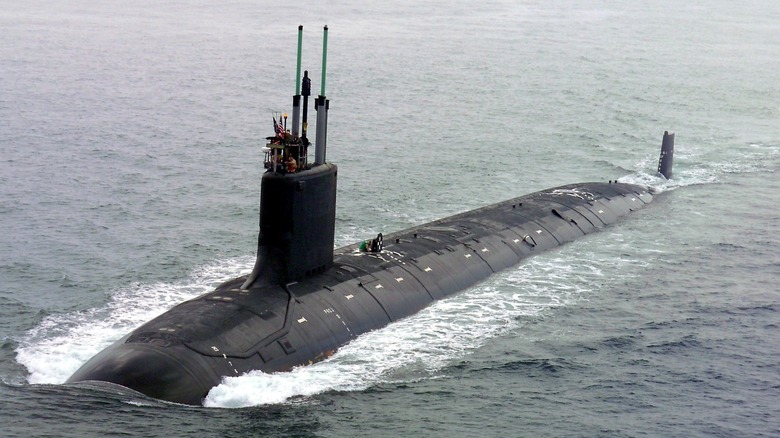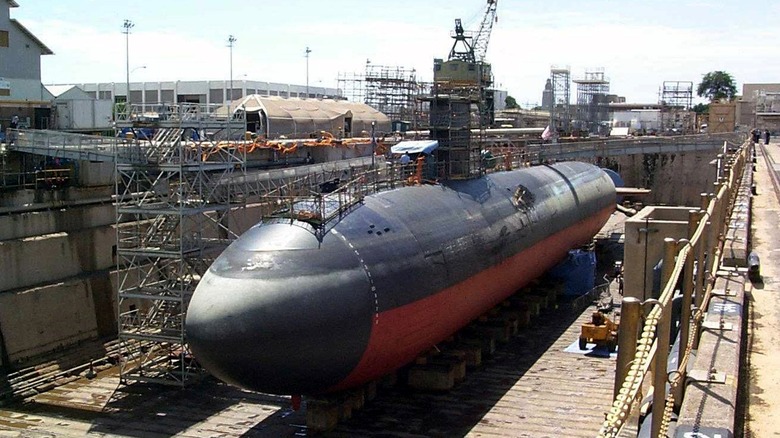
Every military submarine operated by the United States Navy is nuclear-powered, and this has many advantages as well as some disadvantages. The advantages are clear in that a nuclear sub can typically operate for decades without refueling. To do so, they require a Refueling and Overhaul (ROH) process that is complex and sees the submarine not only refuel the reactor during this time, but the Navy also augments the boat's capabilities, improves systems, and modernizes wherever possible during the boat's midlife
point.
The ROH ensures that U.S. nuclear submarines can operate for as long as possible, but it's neither quick, cheap, nor easy. It doesn't take a few months to conduct an ROH — it can take years. Not only that, but the time required varies wildly, depending on what needs to be done. Submarines can take anywhere from one to two years to undergo a complete ROH, which is one of the main reasons they undergo a refit after a decade or two during the boat's midlife point.
A submarine can undergo an ROH and return to operational service for just as long as it did previously. An ROH doesn't usually take much more than a couple of years to complete, but it can take longer. The USS Louisiana (SSBN-743), an Ohio-class nuclear submarine, completed its mid-life Engineered Refueling Overhaul (ERO) in a total of 870,000 resource days, which took place over a period of 40 months. EROs are done to refuel a boat, modernize parts, and perform maintenance without conducting major overhauls of technology, and are meant to extend the life of a submarine, though COVID-19 extended the USS Louisiana's considerably.
Read more: 10 Of The Largest Navies In The World, Ranked By Self-Reported Total Naval Assets
How The Refueling Process Takes Place

Military submarines can stay at sea for up to 20 years or more before requiring refueling. When a nuclear submarine needs to refuel, it heads to a shipyard's dry dock that's drained of seawater. Keel blocks beneath the hull ensure it doesn't roll over or move in any dangerous manner, and the refueling process begins first by allowing the reactor to cool down and cease operation. The fuel within a submarine's nuclear reactor is a solid mass inside the core. By the time refueling is necessary, the core is incredibly radioactive, so safety is a top priority during any ROH or ERO.
Unfortunately, it's not safe to simply swap out the core for a fresh one, as they aren't exactly plug and play. Every surface that comes into contact with the core, including the cooling water, is contaminated and highly radioactive, so the process of removing and replacing it is incredibly slow and methodical. The goal is to swap out the reactor's core as safely as possible, so monitors are on-hand throughout the process to detect radiation and react should a dangerous situation arise.
The ROH is similar to the Refueling and Complex Overhaul (RCOH) process that's performed on U.S. Navy Aircraft Carriers, which can take even longer to refuel. For submarines, the process is similar, but because they're so much smaller and the onboard reactors are more complex, they require more expensive measures to refuel, costing U.S. taxpayers as much as $800 million. Still, putting a boat into drydock for two or more years is far better than scuttling the whole thing and building a brand new nuclear submarine.
Want the latest in tech and auto trends? Subscribe to our free newsletter for the latest headlines, expert guides, and how-to tips, one email at a time.
Read the original article on SlashGear.













